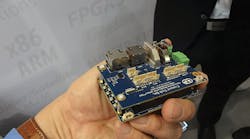This file type includes high-resolution graphics and schematics when applicable.
Computer modules offer a simpler route for implementing the latest processor technology, rather than having to design a whole board. Typically, the carrier board is significantly easier to design. It can also be more cost-efficient since the carrier board often has fewer layers.
Of course, pushing the performance envelope generally means dissipating a bit more heat. This is where cold plates, heatsinks, and heat pipes come into play. Incorporating cold plates into modules not only helps with heat issues—it also simplifies mechanical design chores.
Cool, fanless solutions come in many forms. For instance, VersaLogic's Hawk (Fig. 1) is a multi-board solution that puts the cold plate at the bottom of the stack, where it can be easily mounted on a metal case to help dissipate the heat. The Hawk runs a quad-core, 1.9-GHz, Intel Atom Bay Trail processor. The processor board includes up to 4 GB of DDR3L RAM and 8 GB of eMMC flash storage.
The top board in the stack has a microSD socket, a SATA connection, and a Mini PCIe card socket that can handle a range of peripheral and storage solutions (see “PCI Express Mini Card Tackles Compact Embedded Expansion”). The system is designed for industrial operations from –40° to +85°C and shock/vibration-qualified to MIL-STD-202G.
Most plates have a hole pattern that allows them to be bolted to a case. Often, a conductive paste is placed between the the two surfaces to improve thermal exchange.
Nvidia's Jetson TX1 module (Fig. 2) features a single chip that includes Nvidia’s Maxwell GPU with 256 CUDA cores along with ARM Cortex-A57 and Cortex-A53 cores in ARM’s big.LITTLE arrangement (see “Module Delivers Supercomputer Performance”). It is one hot chip, in more ways than one. However, it can be conduction-cooled, hence the plate covering the back of the Jetson TX1 module. The system delivers over 1 TFLOPS of performance and supports 4K video encode and decode. It also supports OpenGL 4.5, OpenGL ES 3.1, and Vulkan, and manages up to six cameras running at 1400 Mpixels/s. Bluetooth and 802.11ac wireless is built into the module as well.
The Nvidia platform supports a range of software, including cuDNN, a CUDA-accelerated library for deep learning. It’s compatible with deep-learning frameworks like Caffe, Theano, and Torch.
The Jetson TX1 module includes 5 GB of LPDDR4 memory and 16 GB of eMMC flash. It’s designed to plug into carriers like Connect Tech's Astro Carrier (Fig. 3). The device brings out the wired interfaces like SATA and Gigabit Ethernet, along with the various serial ports. Among other features are two Gigabit Ethernet ports, three camera interfaces, audio ports, USB 2.x and 3.0 ports, and HDMI ports. Both the Astro Carrier and Jetson TX1 can handle industrial temperature ranges. The middle carrier board has a half-size mSATA socket, plus a Mini-PCIe socket with PCIe and USB support.
Creating fanless, small-form-factor solutions doesn’t mean designers need to give up performance. It’s just a matter of keeping the hardware cool enough using solutions like the Hawk and Jetson TX1.
Looking for parts? Go to SourceESB.




